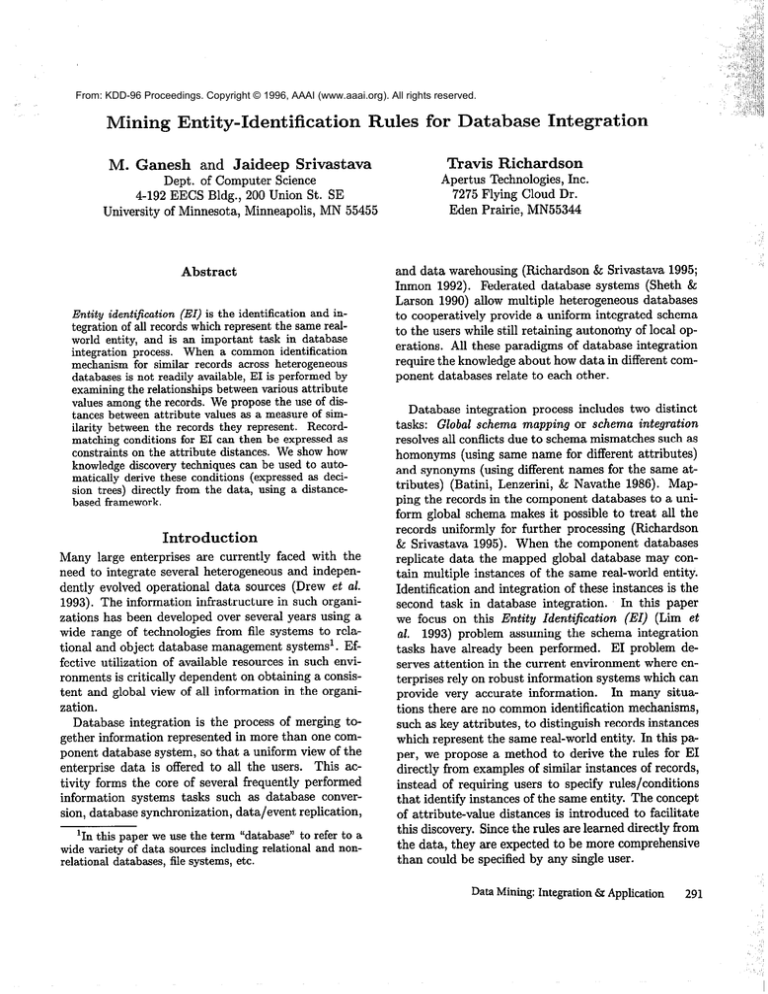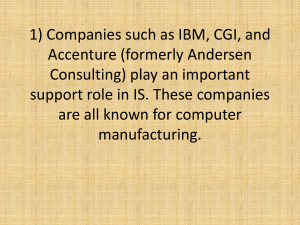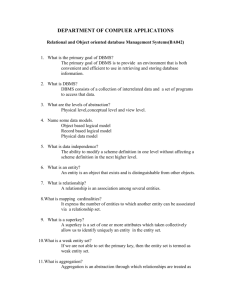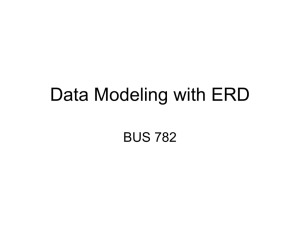
From: KDD-96 Proceedings. Copyright © 1996, AAAI (www.aaai.org). All rights reserved.
Mining
Entity-Identification
M. Ganesh
and Jaideep
Rules for Database
Srivastava
Dept. of Computer Science
4-192 EECS Bldg., 200 Union St. SE
University of Minnesota, Minneapolis, MN 55455
Abstract
Entity identification (EI) is the identification and integration of all recordswhich representthe samerealworld entity, and is an important task in database
integration process. When a common identification
mechanism
for similar
records across heterogeneous
databasesis not readily available,EI is performedby
examining the relationships between various attribute
values among the records. We propose the use of distances between attribute values as a measure of similarity betweenthe records they represent. Recordmatching conditions for EI can then be expressed as
constraints on the attribute distances. We show how
knowledge discovery techniques can be used to automatically derive these conditions (expressed as decision trees) directly from the data, using a distancebased framework.
Introduction
Many large enterprises are currently faced with the
need to integrate several heterogeneous and independently evolved operational data sources (Drew et al.
1993). The information infrastructure in such organizations has been developed over several years using a
wide range of technologies from file systems to relational and object database management systems1. Effective utilization of available resources in such environments is critically dependent on obtaining a consistent and global view of all information in the organization.
Database integration is the process of merging together information represented in more than one component database system, so that a uniform view of the
enterprise data is offered to all the users. This activity forms the core of several frequently performed
information systems tasks such as database conversion, database synchronization, data/event replication,
‘In this paper we use the term “database” to refer to a
wide variety of data sourcesincluding relational and non-
relational databases,file systems,etc.
Travis
Integration
Richardson
Apertus Technologies, Inc.
7275 Flying Cloud Dr.
Eden Prairie, MN55344
and data warehousing (Richardson & Srivastava 1995;
Inmon 1992). Federated database systems (Sheth &
Larson 1990) allow multiple heterogeneous databases
to cooperatively provide a uniform integrated schema
to the users while still retaining autonotiy of local operations. All these paradigms of database integration
require the knowledge about how data in different component databases relate to each other.
Database integration process includes two distinct
tasks: Global schema mapping or schema integration
resolves all conflicts due to schema mismatches such as
homonyms (using same name for different attributes)
and synonyms (using different names for the same attributes) (Batini, Lenzerini, & Navathe 1986). Mapping the records in the component databases to a uniform global schema makes it possible to treat all the
records uniformly for further processing (Richardson
& Srivastava 1995). When the component databases
replicate data the mapped global database may contain multiple instances of the same real-world entity.
Identification and integration of these instances is the
second task in database integration. In this paper
we focus on this Entity Identification (EI) (Lim et
al. 1993) problem assuming the schema integration
tasks have already been performed. EI problem deserves attention in the current environment where enterprises rely on robust information systems which can
provide very accurate information. In many situations there are no common identification mechanisms,
such as key attributes, to distinguish records instances
which represent the same real-world entity. In this paper, we propose a method to derive the rules for EI
directly from examples of similar instances of records,
instead of requiring users to specify rules/conditions
that identify instances of the same entity. The concept
of attribute-value distances is introduced to facilitate
this discovery. Since the rules are learned directly from
the data, they are expected to be more comprehensive
than could be specified by any single user.
Data Mining: Integration 6r Application
291
Employee
1
Name
Address
1 City 1 Zip 1 State 1 Age 1
ID
1 TelNum I Salary 1
1 Johns Smith I 935 Shady Oak 1 F’ridley I 55532 1 MN 1 28 I 333444555 I 421-5533 I 25000 1
Student
1
Name
1
Street
I City I Zipcode I Birthdate I
ID
I Home Ph I Wagerate 1
1 John Smith I 729 W. 17th I Fridley I 55536 I 052266 I 1314156 I 421-5533 I
7.95
I
Mapped
global
Name
Johns Smith
John Smith
Integrated
table
- Personnel
Address
935 Shady Oak
729 W. 17th
global
table
City
F’ridley
Fridley
Zip
55532
55536
State Age
MN
MN
28
29
TelNum
421-5533
421-5533
Wagerate
12.02
7.95
- Personnel
I
Name
I Address I City I Zip ) State I A
I John Smith I 729 W. 17th I Fridley I 55536 I MN I 2:
I TelNum I Wagerate I
I 421-5533 I 19.97 I
Figure 1: Database integration example
Entity
Identification
Framework
Figure 1 describes a complete example of the integration steps. Two tables, Employeeand Student, from
two different databasesare integrated to obtain a single table Personnel. The key attributes in the two
tables ID are homonyms, i.e. their meanings differ
even though the names are identical. The 1D attribute
in the Employee table refers to social security number
whereas the ID in the Student table corresponds to
an university Id. There are no common keys between
the two tables. After resolving schemaconflicts such as
name m ismatchesbetween attributes, a mapped global
table Personnel is created. Entity identification is then
performed on the mapped global table to determine entities that possibly occur more than once in this table.
This step is required since the component databasetables have no common key. The rule used to identify
instances of the same entity is given as:
Match any 2 of (Name, Address, TelNum)
Two record instances in the mapped global table
with names “Johns Smith” and “John Smith” have the
same value in the “TelNum” field and have “Name”
values which are very similar. Functions that determ ine whether each of the attribute value pairs match
or do not match are defined for each attribute field. If
the match function for the ‘Name” field reports similar names such as the pair above to be a match then
the two record instances will be identified as the same
enitity. The resulting integrated global table is shown
with only one instance for each matching entity sets.
Conflicts among attribute values of the integrated instances are resolved (determining the correct value for
the attribute fields ii different instances have different
values for the same field) using user specified rules.
Rules for EI, specify relationships among attribute
values of instances of the same entity. These rules are
292
Technology Spotlight
obtained from users who have the knowledge of the
data semantics. In many casesthe users are not able to
specify the exact relationships between attribute values which relate instances of the same records. It is
however possible to provide a set of example records
which represent the same entity. The record-matching
rules are therefore implicitly present in the classification of the records into distinct entities. We describe
a framework for learning these rules using the ideas
from clustering and classification algorithms (Agrawal,
Imielinski, & Swami 1993; Han, Cai, & Cercone 1992;
Quinlan 1993). The rules we learn are in the form of
decision trees, although any classification system which
could explain the learnedrules to the users may be used
in its place instead.
Figure 2 showsour framework for performing entity
identification. A data analyst selects a few records
from the mapped global database and labels all instances that represent the same entity with a unique
entity Id. This set of records, classified by their entity
Id, form a training sample for a learning system. The
learning system discoversthe attribute value relationships among records which represent the same enitity
and also the relationships which classify the records as
dissimilar. The relationships thus discovered form the
rules which are used on the unclassified records to perform entity identification.
It is desirable to have the
learning module explain the rules in an understandable form to the data analyst so that s/he can evaluate
them. Depending on the results of this evaluation the
data analyst can alter the training samplesto improve
the quality of rules learned. The integrated instances
are also monitored by the data analyst for evaluation
of the perfortiance of the EI rules.
Integrated
Global
Figure 2: Entity Identification framework
Attribute
Distance
Functions
EI problem can be viewed as determining the clusters to which the individual records belong, where each
cluster represents a real-world entity. We use an initial
set of records whose entity identities (EIDs) are known
as the training set. The record-matching conditions
for any pair of records is an appropriate combination
of the relationships between each pair of attribute values in the records. The relationships between similar
attribute value pairs is then measuredas a distance between their values. A similar pair of attribute values
will have a smaller distance between them, compared
to a dissimilar pair of values which fall into distant regions of the description space. We measure distances
between all such pairs of attribute values to form a
vector of distances for a given pair of data records.
These distance records are categorized into two classes
- “Match” and “No-Match” - depending on whether
they measure the distances between two entities with
similar EIDs or not. These distance records then form
the training set for a learning system which will induce the relationships between attribute distances as
the conditions for the source records to match. Entity
identification problem is thus reduced to a classification problem and we can use any classification system
to learn the rules for EI.
Figure 3 explains the details of the learning module. The training data for the rule induction process
is generated from a set of classified records. Using a
set of N such records we generate v
distance
records, comparing each record against another. Each
type of attribute distances is measured using functions which are specific to the attribute type. e.g.
distances between two strings may be measured using the edit distance, and distance between two names
may be measured using the soundex function (Knuth
1973). These distance records are then assigned the
label “Match” if the corresponding classified records
have the same EIDs, and the label “No-Match” otherwise. Using these distance records as a training sample, a rule learning system induces the conditions under
which a pair of records are similar. These conditions
are then applied to any pair of records in the same
mapped global database to perform EI.
Experimental
Evaluation
Conclusions
and
We have carried out preliminary experiments to evaluate the effectivenessof our approach to EI in database
integration. The experiment used a set of 1100 homogeneized data records from a business customer
database. Each of these records in the database represents one of 20 real-world entities. The records were
labelled with corresponding EIDs and the number of
records corresponding to each of the entities ranged
from 6 to a maximum of 524. We measured the effectiveness of the EI rules learned by their performance
on unseen test casesand the size of the decision trees.
From the data set various sizes of workloads were obtained (50, 100, and 200) and training sets of various
sizes are drawn from the corresponding workloads. In
our experiments we have varied the training set sizes
as 10, 20, 40, 60, 80, and 100% of the test sets. These
training sets are used to generate the decision trees
for classifying the distance records into one of the two
categories, Match or No-Match. The well-known C4.5
algorithm (Quinlan 1993) was used as the rule learning
engine. Decision trees learned were then used to classify the corresponding test sets from which the training
sets were drawn.
This method was able to achieve very high effectiveness for EI. In most cases the pair-wise match errors
DataMining: Integration&ZApplication
293
Classification(Ma
Enti/y ID
Al...Ar
JI
d(A1)
. . d(Ap)
ch/NoMatch)
1
J(
Ei
Rl
R2
R3
W
Ek
Rij
>
n(n-1)/2
records
Em
Rn
Classified
Distance vectors
records
Figure 3: Learning of EI rules
are 5 0.2%) and the number of records misclassified
were 5 1%. Reasonably small error rates are achieved
with about 20% of the data set provided as training
set sizes. As we go beyond 40% of the data set as the
training set size, the tree sizes increase while bringing
only marginal improvement in the classification error
rate. At this stage the rules learned have becomesensitive to the specific data provided as examples. The size
of the decision trees in our experiments varied between
3 and 20 nodes.
We have introduced a framework for the mining of
the EI rules directly from examples of integrated instances of entities, to obtain precise rules. Direct application of learning algorithms to this problem is not
viable becauseof the inability to provide examples of
all possible entities which may occur in a data set.
The concept of attribute-distance functions have been
introduced to facilitate this process. Results obtained
from our experiments demonstrate that this approach
to EI is comparable to the best accuracies of methods where users specify the EI rules without the corresponding human effort. In future work we plan to
include attribute-value conflict resolution part of EI.
We are currently developing efficient algorithms for
performing EI with the distance-based approach and
using the distance values computed from the induced
rules.
References
Agrawal, R.; Imielinski, T.; and Swami, A. 1993.
Database mining: A performance perspective. IEEE
Transactions on Knowledge and Data Engg. 5(6):914925.
294
Technology Spotlight
Batini, C.; Lenzerini, M.; and Navathe, S. B.
1986. A comparitive analysis of methodologies for
database schema integration. ACM Computing Surveys 18(4):323-364.
Drew, P.; King, R.; McLeod, D.; Rusinkiewicz, M.;
and Silberschatz, A. 1993. Report of the workshop
on semantic heterogeneity and interoperation in multidatabase systems. SIGMOD Record 22(3):47-56.
Han, J.; Cai, Y.; and Cercone, N. 1992. Knowledge discovery in databases: An attribute-oriented
approach. In Proc. of the 18th VLDB Conference,
547-559.
Inmon, W. H. 1992. BuiZdangthe Data Warehouse.
Wiley-QED.
Knuth, D. E. 1973. The Art of Computer Programming; Vol 3: Sorting and Searching. Reading, MA:
Addison-Wesley.
Lim, E.-P.; Srivastava, J.; Prabhakar, S.; and
Richardson, J. 1993. Entity identification in database
integration. In Proc. of the 9th Int? Conf. on Data
Engg., 294-301.
Quinlan, J. R. 1993. C4.5: Programs for Machine
Learning. San Mateo, CA: Morgan Kaufmann.
Richardson, T., and Srivastava, J. 1995. Enterprise/integrator: Using object technology for data integration. In Proc. of Workshop on Legacy Systems
and Object Technology, at OOPSLA
95.
Sheth, A. P., and Larson, J. A. 1990. Federated
database systems for managing distributed, heterogeneous, and autonomous databases. ACM Computing
Surveys 22(3):X33-236.






